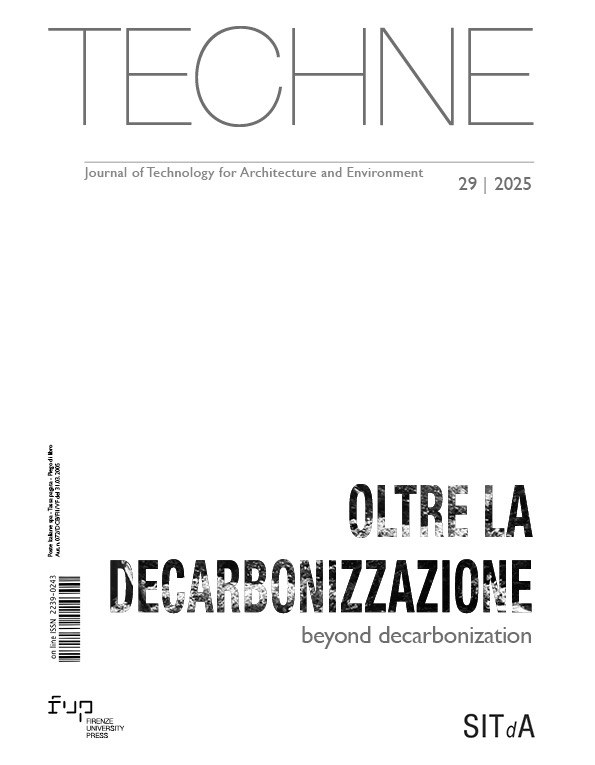Published 2025-07-31
Keywords
- Agrivoltaic systems,
- Climate resilient habitat,
- Decarbonisation,
- Climate neutrality
How to Cite
Copyright (c) 2025 Enza Tersigni, Valeria D'Ambrosio

This work is licensed under a Creative Commons Attribution 4.0 International License.
Abstract
Innovation in the field of agrivoltaic systems involves the adoption of integrated solutions aimed at preserving the continuity of agricultural cultivation activities by applying convergent technological-energy innovations on the one hand, and technological-cultural innovations on the other. Agrivoltaic systems can be framed in the category of biotech integrated systems, and their implementation looks at innovative climate resilient habitat models, favouring a compatible combination of anthropic and environmental components. The paper reports on the outcomes of the activity of a research group of the Department of Architecture, University of Naples Federico II, conducted in the framework of the integrated project ‘High-efficiency photovoltaics’ (PTR 2022-2024), The aim was to define support tools for environmental sustainability in the design of agrivoltaic systems, starting from the construction of a systematised framework of the main aspects of the technological innovation in its orientation towards increasing climate resilience.
Downloads
References
- Abouaiana, A.A. and, Battisti, A. (2022), “Multifunction Land Use to Promote Energy Communities in Mediterranean Region. Cases of Egypt and Italy”, LAND, Vol. 11, pp. 1-24. Available at: https://doi.org/10.3390/land11050673 (Accessed on 26/12/2024). DOI: https://doi.org/10.3390/land11050673
- Bauman, Z. (1999), Modernità liquida, il Mulino, Bologna.
- Branzi, A. (2006), Modernità debole e diffusa, Il mondo del progetto all’inizio del XXI secolo, SKIRA, Ginevra-Milano.
- Chatzipanagi, A., Taylor, N. and Jaeger-Waldau, A. (2023), Overview of the potential and challenges for Agri-Photovoltaics in the European Union, Publications Office of the European Union, Luxembourg. Available at: doi:10.2760/208702 (Accessed on 26/12/2024).
- Chalkias, D.A., Stathatos, E. (2024), The Emergence of Agrivoltaics, Springer International Publishing, Svizzera. DOI: https://doi.org/10.1007/978-3-031-48861-0
- Giri, N.C., Mohanty, R.C. (2022), “Agrivoltaic system: Experimental analysis for enhancing land productivity and revenue of farmers”, Energy for Sustainable Development, Vol. 70, pp. 54-61. Available at: https://doi.org/10.1016/j.esd.2022.07.003 (Accessed on 26/12/2024). DOI: https://doi.org/10.1016/j.esd.2022.07.003
- Lopez, G., Chopard, J., Persello, S., Juillion, P., Lesniak, V., Vercambre, G., Génard, M. and Fumey, D. (2023), “Agrivoltaic systems: an innovative technique to protect fruit trees from climate change”, Proceeding of XXXI International Horticultural Congress (IHC2022): International Symposium on Innovative Perennial Crops Management. Available at: doi:10.17660/ActaHortic.2023.1366.20 (Accessed on 26/12/2024). DOI: https://doi.org/10.17660/ActaHortic.2023.1366.20
- Kelly, K. (1994), Out of Control: The New Biology of Machines, Social Systems, and the Economic World, Addison-Wesley, Boston.
- Klyk, C. and Schindele, S. (Eds.) (2024), Agrivoltaics: Technical, ecological, commercial and legal aspects, The Institution of Engineering and Technology, London, United Kingdom. DOI: https://doi.org/10.1049/PBPO245E
- SolarPower Europe (2022), EU Market Outlook for Solar Power 2022-2026. Available at: https://api.solarpowereurope.org/uploads/5222_SPE_EMO_2022_full_report_ver_03_1_319d70ca42.pdf?updated_at=2022-12-19T08:21:34.541Z (Accessed on 26/12/2024).
- Toledo, C., Scognamiglio, A. (2021), “Agrivoltaic Systems Design and Assessment: A Critical Review and a Descriptive Model towards a Sustainable Landscape Vision (Three-Dimensional Agrivoltaic Patterns)”, Sustainability, vol. 13,6871. Available at: https://doi.org/10.3390/su13126871 (Accessed on 26/12/2024). DOI: https://doi.org/10.3390/su13126871
- Vittoria, E. (1979), “Abitabilità della campagna: il rapporto agricoltura-architettura”, in Gangemi V. (a cura di), “L’habitat agricolo del basso volturno”, Istituto di Tecnologia dell’Architettura, Facoltà di Architettura dell’Università di Napoli, Napoli.






